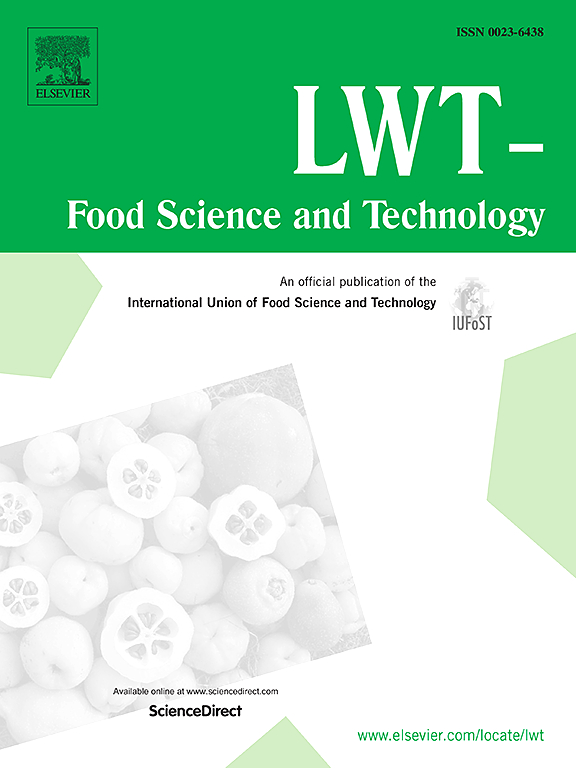使用 YOLOv5 先进检测鲜切蔬菜中的异物
IF 6
1区 农林科学
Q1 FOOD SCIENCE & TECHNOLOGY
引用次数: 0
摘要
近年来,新鲜蔬菜中的异物已成为业界关注的一个重要问题。要确保消费者和供应商的安全,就必须采取全面的预防措施。本研究介绍了一种利用 YOLOv5 检测鲜切蔬菜中异物的新方法。结果表明,YOLOv5s 在识别异物方面表现出色,检测准确率高达 98.30%,推理时间仅为 2.6 ms,模型大小仅为 13.3 MB。该模型能有效识别透明和彩色塑料、纸张、木材、石头、昆虫、玻璃和金属等异物。此外,YOLOv5s 还能准确检测出与青葱颜色相似的异物,而由于青葱的颜色变化很大,这一点尤其具有挑战性。因此,对外来物体数据集进行了测试,结果显示卷心菜和葱的检测率分别为 98.63% 和 98.67%。此外,YOLOv5s 还成功检测出两种鲜切蔬菜中的小异物(2-3 毫米)。尽管性能出色,但 YOLOv5s 模型在识别与蔬菜样本重叠的异物时仍有困难。要解决这个问题,安装自动传送装置可以促进样品的连续移动,而安装进样装置则可以减少重叠的可能性。这项研究证明了使用 YOLOv5s 作为检测鲜切蔬菜中异物的非破坏性技术的可行性。研究结果有助于开发一种准确、快速、高效的实时检测系统,并有可能应用于鲜切蔬菜行业,以提高产品质量和安全性。本文章由计算机程序翻译,如有差异,请以英文原文为准。
Advanced detection of foreign objects in fresh-cut vegetables using YOLOv5
The presence of foreign objects in fresh-cut vegetables has become a significant concern for the industry in recent years. Ensuring the safety of consumers and suppliers necessitates comprehensive precautionary measures. This study introduces a novel approach for detecting foreign objects in fresh-cut vegetables using YOLOv5. The results indicate that YOLOv5s excels in identifying foreign objects with a high detection accuracy of 98.30%, a rapid inference time of 2.6 ms, and a compact model size of 13.3 MB. The model effectively identified foreign objects such as transparent and colored plastic, paper, wood, stone, insects, glass, and metal. Moreover, YOLOv5s accurately detected foreign objects with color similarities to green onions, which is particularly challenging due to their wide color variation. Hence, the foreign objects dataset was tested and generated 98.63% and 98.67% for cabbage and green onion, respectively. Additionally, YOLOv5s successfully detected small foreign objects (2–3 mm) in two types of fresh-cut vegetables. Despite its excellent performance, the YOLOv5s model struggles to identify foreign objects that overlap with vegetable samples. To address this issue, installing an automatic conveyor unit could facilitate continuous sample movement, while a feeder unit could reduce the possibility of overlap. This research demonstrates the feasibility of implementing the YOLOv5s, as a non-destructive technique for detecting foreign objects in fresh-cut vegetables. The findings contribute to the development of an accurate, fast, and efficient real-time inspection system, with potential applications in the fresh-cut vegetable industry to enhance product quality and safety.
求助全文
通过发布文献求助,成功后即可免费获取论文全文。
去求助
来源期刊

LWT - Food Science and Technology
工程技术-食品科技
CiteScore
11.80
自引率
6.70%
发文量
1724
审稿时长
65 days
期刊介绍:
LWT - Food Science and Technology is an international journal that publishes innovative papers in the fields of food chemistry, biochemistry, microbiology, technology and nutrition. The work described should be innovative either in the approach or in the methods used. The significance of the results either for the science community or for the food industry must also be specified. Contributions written in English are welcomed in the form of review articles, short reviews, research papers, and research notes. Papers featuring animal trials and cell cultures are outside the scope of the journal and will not be considered for publication.
 求助内容:
求助内容: 应助结果提醒方式:
应助结果提醒方式:


